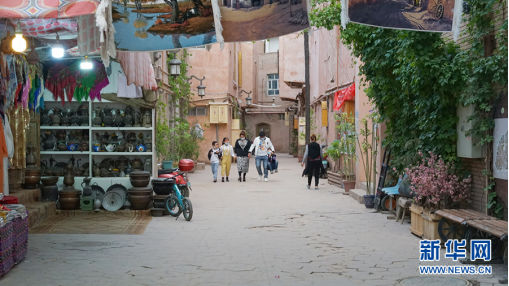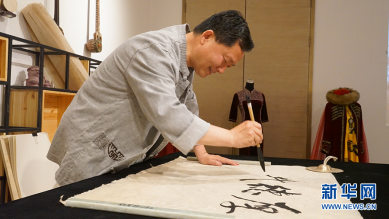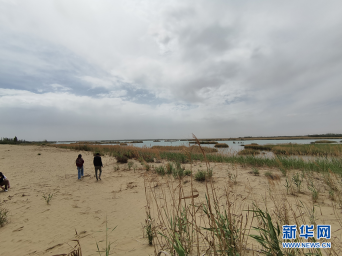Far away from ocean, this is the hinterland of Eurasia. For thousands of years, Tarim river rising in Pamirs, nourishes oases in the desert and the civilizations along the river. No matter the glories past of ancient Silk Road or the new present, the stories here are fascinating.
The time-horned city – Kashgar
Located in northwest China’s Xinjiang Uygur Autonomous Region, Kashgar is an important trading spot on the ancient Silk Road that links China, Middle East and Europe and thus embraces cultures of the east and the west. Today it is still a vigorous business town.

The dance show in the tourist spot, Ancient City of Kashgar. (Xinhuanet, Li Mengting)
The Ancient City of Kashgar is one of the world’s largest earth architectural complexes. To better protect the historic area, a renovation project with an investment of more than 7 billion yuan (1.08 billion U.S. dollars) started in 2010,giving the Ancient City a vibrant new look.

A lane in the Ancient City of Kashgar. (Xinhuanet, Li Mengting)
Well-preserved labyrinth of streets, narrow lanes and crowded dwellings with elaborately carved doors and windows, everything in the Ancient City of Kashgar tells stories of past and present.

A lane in the Ancient City of Kashgar. (Xinhuanet, Li Mengting)
Even in the narrow lanes and crowded dwellings, local people will not forget to decorate the environment with green plants. And Mulberry trees are their favorite. In the harvest time of mulberry, the sweet little fruits will bring both owners and guests joys of sharing under the trees. The juicy and sweet fruit shows the hospitality of the host as well as the open-hearted joys of strangers and old friends.

Tourists are tasting mulberries. (Xinhuanet, Li Mengting)
The Ancient City of Kashgar is also known for its bustling bazaars, featuring different trades: local cuisine, handicraft products, antiques and jewelry.

The flowerpot bazaar. (Xinhuanet, Li Mengting)
Besides bazaars,lanes and dwellings, there is a new way to know the city, home-stay. In Bagqi lane, where home-stay hotels are gathering, tourists and local kids sit on the wood chairs or swings chatting to pass their leisure time.

The home-stay street in the Ancient City of Kashgar. (Xinhuanet, Li Mengting)

The home-stay street in the Ancient City of Kashgar. (Xinhuanet, Li Mengting)
A 36 years old lady, Zhang Jiayi, from Henan province decided to quit her job and started a new one, when she first visit this Ancient City. Last year, she opened a home-stay in Bagqi lane with her girlfriend. “All the efforts have been put into this home-stay. Life is not only about compromise, but also poems and dreams. And in next ten years, this home-stay is our dream.” said Zhang.

The home-stay run by Zhang Jiayi. (Xinhuanet, Li Mengting)
Mulberry-bark paper making,a craft of over 1 thousand years of history
A unique paper making craft, mulberry-bark paper making has been inherited for over one thousand years in Purgakq township, Moyu County, Hotan, northwest China’s Xinjiang Uygur Autonomous Region, which is listed as a Chinese national intangible cultural heritage.

Buzeynep Simail beats the bark after it is boiled and soaked. (Xinhuanet, Li Mengting)
Buzeynep Simail is beating a lump of cooked mulberry bark in her family workshop.
The raw material of making the paper is mulberry tree bark.The inner skin of the mulberry bark is glutinous and the fiber is fine and smooth, hence it is easy to process. The bark is peeled, soaked, boiled, beaten, fermented, filtered, molded and dried, before being made into paper. All by hand, the laborious and time consuming processes of making the paper explains why it remains rare today.The mulberry-bark paper making craft has been listed as a Chinese national intangible cultural heritage in 2006.
The 44 years old Buzeynep Simail is the 12th inheritor of the handicraft in her husband family.

Buzeynep Simail checks a piece of mulberry-bark paper. (Xinhuanet, Li Mengting)
Thanks to the rising of tourism, Buzeynep Simail feels positive about the mulberry-bark paper in future. “In recent year, more and more tourists visit here, and our sales increase year by year.” Buzeynep Simail hopes that her 19 years old son could inherit the craft and introduce the mulberry paper to more people with the development of booming tourism.

A tourist chooses mulberry-bark paper to buy. (Xinhuanet, Li Mengting)
Cao Jianbin, a Chinese painting artist, likes to use mulberry paper in his creation. “The hand-made mulberry paper has a quality of being antiseptic, absorbent and tensile. And it inspired me a lot when painting desert, mountains on this kind of rough texture.” he said.

Cao Jianbin is writing on the mulberry paper. (Xinhuanet, Li Mengting)
“Sea” in the desert – Lalikun National Wetland Park
Lalikun National Wetland Park is located by the China’s largest desert Taklamakan desert. 40 kilometers away from Moyu County, the wetland is the Important ecological barrier, which cuts off the wind and sand from the desert.

Lalikun National Wetland Park. (Xinhuanet, Li Mengting)
Overlooking the Lalikun National Wetland Park. (Provided by Hotan Culture and Tourism Bureau)
27 years old Xing Peng, majored in landscape engineering at university, works in the park. According to his introduction, Lalikun is an important transit station for migratory birds on the migration line to East Africa and West Asia.

Lalikun National Wetland Park. (Xinhuanet, Li Mengting)
According to Xing Peng, based on the principle of protective development, living space and ecological chain of animals in the wetland shall be well protected. Bird rescue station has been set up to help birds and other animals that are injured or sick during migration. To Xing Peng, Lalikun is not only a paradise for wild animals and plants, but also a science center for human to have close contact with nature and wild animals and plants. He hopes that more and more visitors could pay attention on the ecology, and protect the earth on which people live.

Birds are flying in the Lalikun National Wetland Park. (provided by Hotan Culture and Tourism Bureau)

Lalikun National Wetland Park. (Xinhuanet, Li Mengting)
Media Contact
Company Name: Xinhuanet co.,ltd.
Contact Person: Best Ha
Email: Send Email
State: Xinjiang
Country: China
Website: http://www.xj.xinhuanet.com